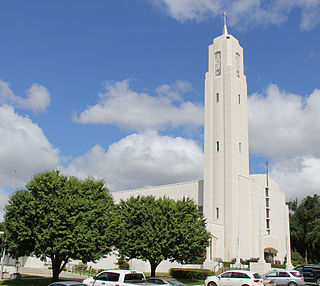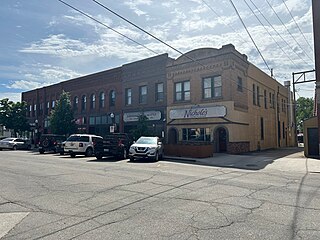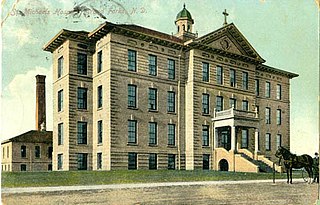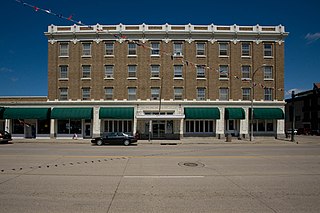
Stark County Courthouse is a historic courthouse in Dickinson, North Dakota, United States, which was built in 1936–1937. It was added to the National Register of Historic Places on November 25, 1985.

The Cathedral of the Holy Spirit is a cathedral and parish church of the Catholic Church located in Bismarck, North Dakota, United States. It is the seat of the Diocese of Bismarck. Since 1980, the cathedral and the nearby Bishop's Residence have been contributing properties in the Bismarck Cathedral Area Historic District on the National Register of Historic Places.
Cole Hotel, also known as Cole European Hotel, was a hotel in Fargo, North Dakota, United States. The hotel building was listed on the National Register of Historic Places in 1983 and was removed from the National Register in 2009.
The Elliot–Powers House and Garage is a property in Fargo, North Dakota that was determined eligible for listing on the National Register of Historic Places on April 7, 1987, with reference number 87002634. It was not, however, actually listed, due to owner objection. Its listing status is "DO/Owner Objection".

The Knerr Block, Floyd Block, McHench Building and Webster and Coe Building is a set of four buildings in Fargo, North Dakota that was listed on the National Register of Historic Places in 1983. The four buildings were built in 1900, 1902, and 1910. The oldest, the Webster and Coe building, was built in 1900 by a carpenter or contractor named Martel. The McHench Building was designed by the Hancock Brothers architects. The "four adjacent buildings constitute a solid front of excellent early turn-of-the-century commercial structures, displaying a continuity of fenestration and decorative brickwork."

St. Michael's Hospital and Nurses' Residence is a property in Grand Forks, North Dakota that was listed on the National Register of Historic Places in 1995. It was also known as St. Anne's Guest Home and denoted 32GF14, it was builtin 1907. It was designed by architect George Hancock. Grand Forks architect William J. Edwards designed the Nurses' Residence in 1913.

George Hancock was an architect active in North Dakota, Montana and Minnesota.

St. James Basilica is a Latin Catholic parish church in the Diocese of Fargo as well as a minor basilica located in Jamestown, North Dakota, United States. A previous church building, completed in 1882, served briefly as a cathedral in the 19th century. The present church building was listed on the National Register of Historic Places in 1982 as St. James Catholic Church, and it was elevated to a minor basilica in 1988.
Grace Episcopal Church is a historic Episcopal church building is located at 210 C Avenue, South, in Minnewaukan, Benson County, North Dakota.

The Trail County Courthouse in Hillsboro, North Dakota is a Beaux Arts building that was built in 1905. It was designed by Buechner & Orth and has a tall domed tower.

The State Normal School at Valley City Historic District, in Valley City, North Dakota, is listed on the National Register of Historic Places. It is a 10.4-acre (4.2 ha) historic district that covers the State Normal School at Valley City campus, now known as Valley City State University, and previously also known as the Valley City State Teachers College and as the Valley City State College.

Haxby & Gillespie was an architectural firm from Fargo, North Dakota. R. J. Haxby and William D. Gillespie were the partners. The firm "produced a number of important buildings throughout North Dakota." They designed many notable public, educational, commercial, and church buildings, in North Dakota, Minnesota, and Montana.

William F. Kurke (1889–1965) was a prolific architect in North Dakota.

The Leach Public Library in Wahpeton, North Dakota was built in 1923. It was listed on the National Register of Historic Places in 1990.

The Union Storage & Transfer Cold Storage Warehouse and Armour Creamery Building in Fargo, North Dakota, United States, was built in 1930. It includes work by Fargo architect William F. Kurke.

The Lewis and Clark Hotel in Mandan, North Dakota was built in 1918. It was listed on the National Register of Historic Places in 1983.

The German Evangelical St. Johns Church on Church Avenue in Hebron, North Dakota, also known as the Deutsche Evangelische St. Johannes Kirche, is now known as St. John United Church of Christ. The church building was listed on the National Register of Historic Places in 2001.

Frederick W. Keith (1879-1954) was an American architect, beginning his career in Indianola, Iowa but gaining prominence while practicing in Grand Forks, Bismarck, and Fargo, North Dakota. After a successful independent practice, he joined forces with William F. Kurke as Keith & Kurke.

The M.E. Beebe Historic District. in Fargo, North Dakota, is a .48 acres (0.19 ha) historic district which was listed on the National Register of Historic Places in 2015.

The Federal Building and U.S. Post Office at 657 2nd Ave. in Fargo, North Dakota, was built in 1969–70. It was listed on the National Register of Historic Places in 2021.



















